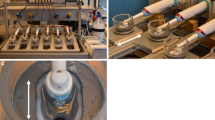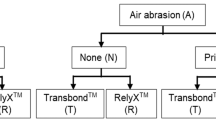Abstract.
Aim:
To determine the elemental composition, microstructure, and hardness of two different brands of titanium (Ti) orthodontic brackets.
Materials and Methods:
Four specimens of each brand were embedded in epoxy resin and, after metallographic grinding and polishing, were studied under a metallographic microscope. The bonding base morphology of each bracket was studied in as-received brackets by scanning electron microscopy. Energy dispersive x-ray microanalysis (EDS) was used on polished specimens to assess the elemental composition of base and wing bracket components, and the brackets were subjected to metallographic etching to reveal the metallurgical structure. The same specimen surfaces were used for assessment of the Vickers hardness. The results were statistically analyzed by two-way analysis of variance (ANOVA) with the bracket brand and bracket region (base, wing) serving as discriminating variables, whilst further group differences were investigated with Tukey’s multiple comparison test at the α = 0.05 level of significance.
Results:
Metallographic imaging revealed that the Orthos2™ brackets (Ormco, Glendora, CA, USA) consist of two parts joined together by laser welding, with large gaps along the base wing inteface, whereas Rematitan® brackets (Dentaurum, Ispringen, Germany) are single-piece appliances. Ti was the only element identified in Rematitan® and Orthos2™ base materials, while aluminium (Al) and vanadium (V) were also found in the Orthos2™ wing component. Metallographic analysis showed the presence of a + b phase for Orthos2™ and plate-like grains for Rematitan®. The results of the Vickers hardness testing were: Orthos2™ (wing): 371 ± 22, Rematitan® (wing): 272 ± 4, Rematitan® (base): 271 ± 16, Orthos2™ (base): 165 ± 2.
Conclusion:
The findings of the present study suggest that there are significant differences in composition, microstructure and hardness between the two commercial types of Ti brackets tested; the clinical implications of the findings are discussed.
Zusammenfassung.
Ziel:
Die Untersuchung der elementaren Zusammensetzung, Mikrostruktur und Härte von zwei orthodontischen Titanbrackets unterschiedlicher Hersteller war das Ziel dieser Studie.
Material und Methode:
Vier Prüfkörper jedes Herstellers wurden in Epoxidharz eingebettet und nach dem metallographischen Schleifen und Polieren unter einem metallographischen Mikroskop untersucht. Die Morphologie der Adhäsionsbasis eines jeden Brackets wurde bei fabrikneuen Brackets rasterelektronenmikroskopisch analysiert. Bei den polierten Prüfkörpern wurde die energiedispersive Röntgenmikroanalyse (EDS) angewandt, um die elementare Zusammensetzung der Basis- und Flügelkomponente des Brackets festzustellen. Außerdem wurden die Brackets der metallographischen Ätzung ausgesetzt, um die metallurgische Struktur hervorzuheben. Dieselben Oberflächen der Prüfkörper wurden für die Bestimmung der Vickershärte herangezogen. Die Ergebnisse wurden statistisch mit Hilfe einer zweifaktoriellen Varianzanalyse (ANOVA) ausgewertet, wobei der Hersteller und die Bracketregion (Basis, Flügel) als diskriminierende Variablen dienten. Andere Gruppenunterschiede wurden hingegen mit dem Tukey- Test für multiple Vergleiche auf dem Signifikanzniveau von α = 0,05 untersucht.
Ergebnisse:
Das metallographische Bildgebungsverfahren zeigte, dass die Orthos2™-Brackets aus zwei durch Laserschweißung miteinander verbundenen Teilen bestehen, die große Spalten an der Grenzfläche von Basis und Flügel aufweisen, während die Rematitan®-Brackets aus einem Stück gefertigt sind. Titan war das einzige Element, das als Material für die Basis von Rematitan® und Orthos2™ gefunden wurde. Aluminium und Vanadium wurden hingegen auch in der Flügelkomponente der Orthos2™ festgestellt. Die metallographische Analyse zeigt das Vorhandensein einer a + b-Phase für die Orthos2™ und eine plattenartige Körnung für Rematitan®. Die Ergebnisse des Vickershärte-Testes offenbarten Folgendes: Orthos2™ (Flügel): 371 ± 22, Rematitan® (Flügel): 272 ± 4, Rematitan® (Basis): 271 ± 16, Orthos2™ (Basis): 165 ± 2.
Schlussfolgerung:
Die Ergebnisse dieser Studie belegen, dass signifikante Unterschiede hinsichtlich Zusammensetzung, Mikrostruktur und Härte zwischen den beiden Titanbrackets verschiedener Hersteller bestehen; die klinische Bedeutung der Ergebnisse wird diskutiert.
Similar content being viewed by others
Author information
Authors and Affiliations
Corresponding author
Additional information
*Ins Deutsche übersetzt von Dr. A. Lindel, Aachen.
Rights and permissions
About this article
Cite this article
Zinelis, S., Annousaki, O., Eliades, T. et al. Metallographic Structure and Hardness of Titanium Orthodontic Brackets. J Orofac Orthop 64, 426–433 (2003). https://doi.org/10.1007/s00056-003-0308-5
Received:
Accepted:
Issue Date:
DOI: https://doi.org/10.1007/s00056-003-0308-5




